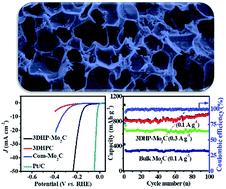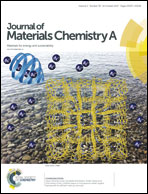A three-dimensional hierarchically porous Mo2C architecture: salt-template synthesis of a robust electrocatalyst and anode material towards the hydrogen evolution reaction and lithium storage†
Abstract
Constructing a three-dimensional (3D) hierarchically porous architecture to increase the active sites and decrease the relevant transfer resistance has been considered as an effective strategy to improve the performance of nanomaterials in electrochemical energy conversion and storage. In this work, we for the first time demonstrate a facile and scalable salt-template method to prepare novel hierarchically macro–meso–microporous molybdenum carbide (Mo2C) with a 3D architecture (3DHP-Mo2C). Remarkably, the well-defined and abundant hierarchical macro–meso–micropores of 3DHP-Mo2C can not only significantly enhance the mass transport and electron transfer, but also markedly increase the specific surface area to effectively expose the electrochemically accessible active sites. Besides, X-ray absorption near-edge structure (XANES) measurements reveal that the carbide matrix can modify the d-electron configuration of the Mo2C particles and impart a moderate Mo–H binding energy. When evaluated as an electrocatalyst for the hydrogen evolution reaction (HER), 3DHP-Mo2C exhibits excellent electrocatalytic performance in terms of small overpotential under both acidic and basic conditions, along with exceptional stability. Apart from its outstanding HER performance, 3DHP-Mo2C also shows a high specific capacity, superior cycling stability and good rate capability as an anode material for lithium ion batteries (LIBs). This synthesis strategy may pave the way to the fabrication of a large variety of promising noble metal-free hybrid materials with a 3D hierarchical pore structure for achieving high-performance applications in energy fields.



 Please wait while we load your content...
Please wait while we load your content...